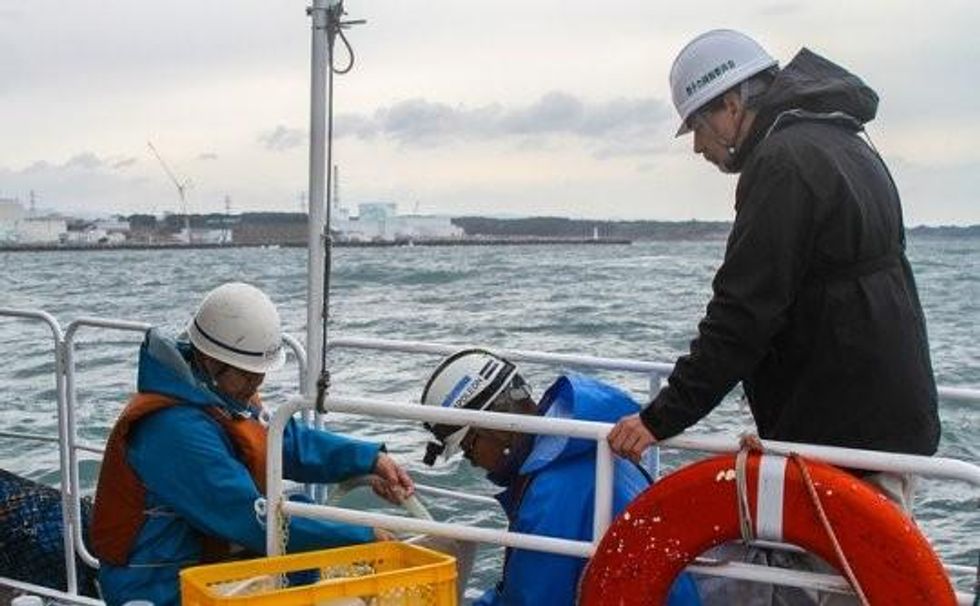A nuclear expert helping with the clean-up at the crisis-stricken
Fukushima plant has joined a chorus of voices saying that all the accumulating radioactive waste water must eventually be dumped into the ocean.
Speaking with Australia's ABC, Dale Klein, former head of the U.S. Nuclear Regulatory Commission (NRC) and current head of the Nuclear Reform Monitoring Committee hired by plant operator TEPCO, described the situation at the plant as "challenging."
Massive amounts of radioactive water used to cool the reactors continue to build up daily in hastily built storage tanks, some which have already leaked, creating an unsustainable scenario.
Eventually, Klein told ABC, that water must be treated to reduce its radioactivity and then dumped into he ocean.
"At the end of the day, when the water is discharged, it will be released in a way that it's diluted," he said.
"So there's no risk to public health and safety. But it's an emotional issue."
More mishaps at Fukushima, like when a rat chewed wiring and caused a power outage, are likely to come, Klein warned.
"I think we will see more of those. When you look at that site, it's massive," he said.
"It's a big site and it's not unusual to have other things like that," he told ABC.
Klein's comments that the waste water will head to the ocean echo those that Lake Barrett, a former NRC official who also serves on TEPCO's committee, offered in an op-ed in the Bulletin of the Atomic Scientists in September.
Barrett wrote that
Spending billions and billions of yen on building tanks to try to capture almost every drop of water on the site is unsustainable, wasteful, and counterproductive. Such a program cannot continue indefinitely. [...]
I see no realistic alternative to a program that cleans up water with improved processing systems so it meets very protective Japanese release standards and then, after public discussion, conducts an independently confirmed, controlled release to the sea.
Also among those calling for the water to be dumped into the ocean is Shunichi Tanaka, head of Japan's Nuclear Regulation Authority, who said in September, "I'm afraid that it is unavoidable to dump or release the water into the sea."
Meanwhile at the crippled nuclear plant, workers this week began a risky yet pressing operation to remove over 1300 fuel rods from Reactor 4.
Explaining why the removal is dangerous yet must be done, nuclear expert Dr. Arjun Makhijani told The Real News Network's Jaisal Noor:
Now, the spent fuel pool number four at Fukushima, which is in question currently, has the most spent fuel of any of the damaged reactors. And the building itself is damaged. And if it is left there, there may be another earthquake. And if the spent fuel pool is destroyed in the next earthquake, there could be a much more severe environmental catastrophe than there was in 2011, in some ways, because the long-lived radioactive material in the spent fuel is more than what was emitted during that accident. I'm talking about long-lived material--cesium, strontium, and so on.
So I believe it is very important to empty spent fuel pool number four especially and put that spent fuel in safer storage.
Look, there's no low-risk solution to this problem. Leaving it there is a significant risk, and removing it also involves significant risks. The spent fuel may be difficult to dislodge because it's no longer in its proper original position. The fuel rods may break, and the fuel may wind up at the bottom of the reactor in the spent fuel pool. There may be an accident of criticality. I haven't examined their plans in detail, but I do think it is very essential to remove this spent fuel, because in my judgment, the bigger danger is leaving it there and waiting for the earthquake to happen. [...]
These pools are sitting high up in the building, and above them there are cranes that move above the spent fuel pools and reactors that transfer fresh fuel into the reactor and used fuel out of the reactor into a pool. So these are pretty heavy pieces of equipment. And those frames were destroyed, along, you know, with the building infrastructure on which they were constructed. So they've had to build a whole new basically impromptu infrastructure to handle this spent fuel that--one hopes that is as precise as the other one, but it's doubtful whether it can replicate the precision of the old, original crane, which could go back and forth above the pool. But it is--you know, they have actually built some kind of a structure, protective structure, not like the original containment. And they also have built a new crane and remote handling for the fuel.
_________________



